I’m sorry it’s been over a month since I updated. The thing about spring is that you’ve got so much to do in the garden that’s it’s often a choice (at least for me) between updating the garden blog and actually being out in the garden! I have some partially finished posts saved on my computer and hopefully I will be able to finish those and upload them soon. I also have a lot of photographs to upload, hopefully also soon. In the meantime, here is a brief update on things here in the past month-plus:
*The shade/partial-shade garden in back is doing really well. Spring is really its best season, I think. There have been bulb blooms, woodland phloxes, epimediums, primroses, and violets, and now the columbines and wild native ginger and the alpine strawberries and the last bulb (Silver Bells) and the new lowbush blueberries and new mourning widow cranesbill are blooming, and the foxgloves and comfrey are budded. The foxgloves I seeded in last year have survived the winter with pretty good germination and most of them are budded (in addition to the foxgloves that I had last year; all but one of those have come back for another year). The comfrey is doing unbelievably better than its sad start when I first planted it last year (if I hadn’t watered it regularly, I think it would have died) – it is huge and has several bud clusters and looks like it is forming new ones as well.
*More improbable winter survivors: In the back garden, the Salvia patens has survived another winter, and this year not just one calla lily has survived, but five (so far)! In the front, all the agastaches appear to have survived, even the ones that weren’t supposed to be winter-hardy here. Additionally, the two hardy begonias finally sprouted over the past day, rewarding my belief in them. That means that all but two things survived in pots in the back garden – the ones that didn’t make it were one epimedium and one sedge. Even the other stuff in tiny pots did, like violets and lyre-leafed sage. My incredible experience with this last year led me to take more risks with it this past year, and I know I’m lucky my risking paid off.
*Self-seeding: There has also been some nice self-seeding. I always appreciate plasnts that are tough enough to be able to self-seed in my harsh front garden. The sundial lupine (Lupinus perennis), in particular, has pleased me so. I’ve counted at least five seedlings, some nearish the parent plant but others farther afield in the garden. Sunflowers have again self-seeded and/or been seeded in by birds. It also looks like the tovara (‘Painter’s Palette’) has self-seeded this year (something it is notorious for doing, and how I first got my plants – a friend gave me their self-seeded seedlings), and it looks like there may be at least one baby echinacea as well, which would please me so. The squill, muscari, and glory of the snow have all developed seedheads, but we’ll see if that results in actual self-seeding (I hope so).
*Overwintered plants: I carried out most of the overwintered plants today, another hot and sunny day here. The brugmansia (‘Charles Grimaldi,’ now with me for two years), Cestrum (‘Orange Zest’), and lemongrass have done the best over the winter, all growing significantly from their size in autumn. The sweet violet and fuschia (sharing a pot) and the tweedia and snail vine have also done decently. The bay seems to still be alive but is continuing not to seem particularly happy, still about the same size it was when I got it several months ago. I saw that the nursery is offering bay laurels that are larger and look more robust than the one I got from them last year, and am considering trying a second plant to see if it does better than the first one has.
*Blooms in front: We are up to the stage where the heirloom irises are blooming or budded. ‘Eleanor Roosevelt’ was first (as she is well-known for being even in gardens with dozens of irises), with just one bloom so far. ‘Gracchus’ is blooming now, with several more buds spread over two bloom stalks, and there are many buds on ‘Quaker Lady’ and ‘Mme Chereau,’ which were the two irises to bloom their first year here (last year). My other three irises have yet to show visible bloom stalks, but I haven’t given up hope yet. All seven are growing more robustly than last year (when I think the trauma of having their roots stomped on, having heavy things dragged over, etc. by the workmen really damaged them), so I think there is definitely a possibility they will yet develop bud stalks. The wild native columbine is also blooming (I planted that this spring) as well as the Mt. Atlas daisies, and there are buds on the (parent) sundial lupine, the false/Carolina lupine, the peach-leaaved bellflower, the dianthuses ‘Rainbow Loveliness,’ the chives (which have been budded since the last heat wave in late April), and one each of the perennial salvias and the cranesbills. There are also a lot of blooms on annuals I’ve planted – pansies, violas, bacopas, heliotropes, snapdragons, Swan River daisies, stocks, Felicia heterophyllas (that beyond-gorgeous blue-on-blue daisy that I planted last year, not realizing it was a different Felicia than the species I’d grown the year before until it bloomed), an alpine calendula I’ve not grown before, … Lots of success with direct-sowing in front, as usual. There are a ton of clarkias (nearly 100% germination, as last year) as well as smaller numbers of many other things, such as California poppy, annual poppy, corncockle, calendula, and love-in-a-mist.
*Crops: The fava/broad beans have started blooming! The garden peas are growing like mad now. Some of the garden peas had poor germination in the first round, so I recently seeded in a second batch of those and they are catching up now (‘New Mexico,’ ‘Tall Telephone (AKA Alderman),’ and ‘Mammoth Melting’ are the ones I can remember off the top of my head). I don’t know if it was a difference in placement (perhaps different amount of sunlight/different intensity, different texture to the soil, etc.), if perhaps they happened to be more prone to rotting before sprouting than the other cultivars, or what. The fava/broad beans seem to have had pretty even germination rates amongst them, even though they are planted in a row westish to eastish like the peas are. The lentils, meanwhile, have had very uneven germination. (If you forget, this is my first year growing lentils. See a recent post for more details.) ‘Spanish Pardina’ germinated first and to date has germinated best (I think it may have had 100% germination). ‘Black Beluga’ germinated second and has similarly had overall second-best germination. The other three haven’t done as well, with a handful (‘French Blue,’ ‘Petite Crimson’) to none (‘Urid Dal’) up so far. I’ve also had no srpouts of the garbanzo ‘Black Kabouli,’ but my beans ‘Yellow Arkiara’ (the earliest garden bean to plant) have sprouted and are growing nicely, and now with the heat and sun, the runner beans and purple-podded beans are coming up as well. (Purple-podded beans can be planted earlier than other beans because there’s a special chemical in them that both gives them the purple coloring and makes them less prone to rotting in cool, wet soil.) Aphids turned out to have sheltered over the winter on the fuschias and decimated the majority of my seedlings in just a day. After they had mostly died out, I started a second batch of seedlings. I’ve got lots of young plants again now: 26 cherry tomatoes (nearly 100% germination), 20 regular-sized tomatoes, 12 tomatillos, and 2 chiles (the chiles survived the onslaught better than the tomatoes and tomatillos, so I didn’t seed as many new ones in). I’ve never had aphids on indoor seedlings before, and it’s really a serious pain. I also got a cherry tomato plant at the living green festival my town held recently. A non-profit that does gardening work locally was selling them to raise money. They said it was an heirloom hand-selected by their main grower (and indeed, it appears to be named after him), but the two people staffing the stall couldn’t tell me more about it. When I tried to ask more detailed questions, they just kept shrugging and saying, “It’s a cherry tomato,” as if that explained everything. So I figured I’d just grow it and see for myself what the answers to my questions are. There are also shallots, parsley, cilantro, French sorrel, thyme, and sage growing in front, and the scallions, chives (or as the person that gave me the Chinese leek division two years ago calls them, “American chives”), lavenders, winter savory, and Chinese leek/garlic chives have all survived the winter and are doing excellently. I also finally planted the bare-rooted highbush blueberries in front since my last post, and after initial shock, they seem to be adjusting well. In the sifted compost, I found a squash vine, and transplanted it to the main crop area. I’ve also got melon seeds to sow. Today’s a ‘fruit day’ in biodynamic parlance, as is tomorrow, so I should do that while the time is right. Perhaps I should seed in my edamames today too, and give them a chance to get going before the pole beans shade them out (which seems to have been their biggest problem the last two years).
*Compost: Yesterday, in anticipation of yesterday and today’s heat, sun, and wind, I mulched all the back beds and the main crop area in the front bed with compost. I also top-dressed the front’s plants that I know most like it – the Oriental poppies, peonies, scallions, and chives – plus I added some compost around the blueberries, stocks, and alpine calendula.
*Caterpillars: I found a caterpillar in the crop patch recently, the first I’ve ever seen in the windy, hot, high front garden! It was so convincing at playing dead I thought it really might actually be dead until I gently poked it with a twig and it freaked out. I also found a couple caterpillars in the back garden yesterday, one green and hanging out on the sifted-compost holder and the other munching the comfrey.
*New plants: I mentioned some of the new plants above. I’ve also gotten more new plants from the nursery and mail-order. I’ve planted some of them and others are awaiting planting. Some of them, particularly much from my Select Seeds mail-order, are meant to go in pots: a datura, petunias, fuschias, tender (‘zonal’) geraniums. I’ve also got flowering tobacco, salvias, tender vines, coleuses, and more from Select Seeds. I’ve already planted lantanas and some salvias and a double-flowered feverfew and a silver foliage plant from them. I’ve also got some tender “bulbs” to plant – dahlias and gladiolas and a rain lily from Old House Gardens and a few cannas from the local hardware store (Old House Gardens had already sold out of cannas by the time I placed my quite tardy order).
I think that’s plenty for today! More another day.


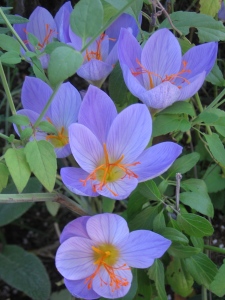
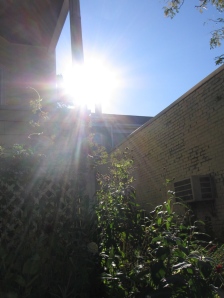

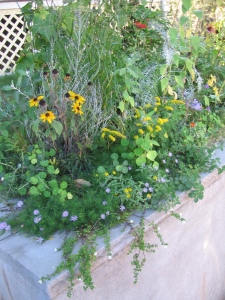

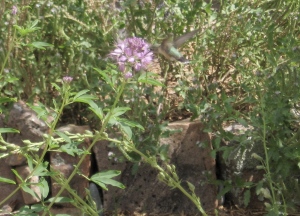
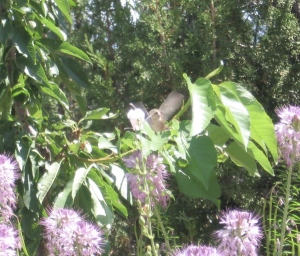

Recent Comments